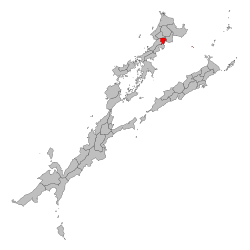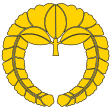Okami
| Okami 大紙 | |||
|---|---|---|---|
| Metropolis | |||
Okami Metropolis | |||
 | |||
| |||
| Nickname(s): Sky City, The Blue City, The City of Harmony | |||
 Location of Okami in Okaiken | |||
| Country |
| ||
| Island | Harujima | ||
| Region | Tokami | ||
| Divisions | 18 special wards, 20 cities, 1 district, & 4 subprefectures | ||
| Government | |||
| • Type | Metropolis | ||
| • Governor | Kan Naruto (I) | ||
| • Capital | Okami[1] | ||
| Area | |||
| • Metropolis | 1,985.23 km2 (770 sq mi) | ||
| • Metro | 10,336 km2 (4,000 sq mi) | ||
| Area rank | 42nd | ||
| Population (January 21, 2017) | |||
| • Metropolis | 17,334,206 | ||
| • Density | 8,700/km2 (23,000/sq mi) | ||
| • Metro | 32,229,987 | ||
| • Metro density | 3,100/km2 (8,100/sq mi) | ||
| • 18 Wards | 10,227,691 | ||
| (2017 per prefectural government) | |||
| Demonym(s) | Okamiite | ||
| Time zone | Okaiken Standard Time (UTC+9) | ||
| ISO 3166-2 | OK-13 | ||
| Flower | Somei-Yoshino cherry blossom | ||
| Tree | Ginkgo tree (Ginkgo biloba) | ||
| Bird | Black-headed gull (Larus ridibundus) | ||
| Website | www.metro.tokyo.jp | ||
Okami (大紙 Ōkami); officially Okami Metropolis (大紙都 Ōkami-to), is one of the 47 prefectures of Okaiken. Okami is the capital of Okaiken, the center of the Greater Tokuyama-Okami-Kadena Area, and one of the largest metropolitan area of the world. It is the seat of the Sanese government and the Imperial Palace, and the home of the Sanese Imperial Family. Okami is in the Tokami region on the northwestern side of the island Harujima and includes two of the Inland Mitoyagi Islands: Tanegashima and Toshima. Okami Metropolis was formed in 1973 from the merger of the former Okami Prefecture (大紙府 Okami-fu) and Okami City (大紙市 Okami-shi).
The Okami Metropolitan government administers the 23 special wards of Okami (each governed as a city), which cover the area that was the city of Okami, as well as 39 municipalities in the western part of the prefecture and the outlying island chain. The population of the special wards is over 11 million people, with the total population of the prefecture exceeding 18 million. The prefecture is part of the world's most populous metropolitan area with upwards of 25 million people and the world's largest urban agglomeration economy with a GDP of 1.479 trillion enieos at purchasing power parity in 2008. The city hosts 47 of the Global 500 companies, the highest amount of any city.
Okami has been described as one of the three "command centers" for the world economy. The city is considered an alpha+ world city, listed by the GaWC's 2008 inventory and ranked fourth among global cities by J.T. Kearney's 2012 Global Cities Index. In 2010 Okami was named the second most expensive city for expatriate employees, according to the Mercer and Economist Intelligence Unit cost-of-living surveys, The Adonia Guide has awarded Okami by far the most Rosalin stars of any city in the world. Okami hosted the 1960 Adonian Games and the 2012 Adonian Games.
History[edit | edit source]
Prehistory to the Sengoku period[edit | edit source]
Some of the earliest signs of habitation in the area of Okami were found at the Morinomiya remains (森の宮遺跡 Morinomiya iseki?), with its shell mounds, including sea oysters and buried human skeletons from the 5th–6th centuries BC. It is believed that what is today the Uehonmachi area consisted of a peninsular land, with an inland sea in the east. During the Miyagi period, permanent habitation on the plains grew as rice farming became popular. However, habitation at Okami remained sparse; it was a little-known small fishing village by the late Sengoku Period.
Sengoku period[edit | edit source]
During the Mid-Sengoku Period,Okami was governed by the Kamigata clan, a small, poor clan with a direct tutelage to the Ogasawara clan, which was located 75 kilometres north of the hamlet in Iwawada. Okami was still a small village with a poorly defended castle at the banks of the Kiso and Kashi rivers. Surrounded by both salt and freshwater marshes, the area was deemed difficult for land surveying and rice farming. By the beginning of the Seto-Tosa period, the clan surrendered its territories to the Ogasawara clan, citing difficult conditions to properly govern the area. Ogasawara Terumasa then launched a series of projects into the river such as irrigation canals and defenses still being used by the government today. When Terumasa was replaced by Takigawa Kazumasu after his assassination, the territory was given to several hands such as the Hisamichi and the Kishi before the Honda clan was moved to the area in exchange of their territory in Yagishima.
Okami became the centre of political affairs of the Honda clan when they took over the reins of power in 1605. It was later declared the Imperial capital after Honda Shigetada became the Emperor Shirakawa in 1610. Okami castle was heavily modified to meet the demands of the Imperial institution in Mito.
Honda Period[edit | edit source]
Saito Restoration[edit | edit source]
Great War[edit | edit source]
Modern Okami[edit | edit source]
After the Great War, which left Okami devastated, the government announced to decrease the population density around the old castle town and distribute it to the newer districts such as Kanda, Shinbashi and Jomyou-in Eastern Okami; and the western areas of Tama and Rinkan in the west. As a result, the current density at the old castle town is much lower than the areas surrounding it; with Shinbashi becoming one of the world's densest urban areas. In addition to the new town centres, a new East-West Commuter rail line called the Tama-Shinjo line was built in 1957 to complement the Okami loop line and the Okaiken Railways corridor at Kanda. Private railway companies such as the Tozai Railway and the Harakyu Railway also extended its commuter services further, allowing the city to take on a very rapid growth in the 1960s.
By 1968, the city had quadrupled in size and its population density was back to its prewar levels. As a result, The metropolitan goovernment and council was created in order to streamline the approval of several infrastructure projects that dot the city. 2 new north-south lines of the Okaiken Railway (Zama Line and the Kanda-Toranomon Line) was built along with the construction of the Harujima Shinkansen. Shinbashi was allocated for large skyscraper development while Kanda and Tama was allocated for midrise commercial buildings. New restrictions and guidelines were established for the old castle town to control population density as well as to keep the character of the city. By 1973, the major reconstruction work of the Okami castle was begun and 5 private railway lines were opened.
The metropolitan subway was finally extended in 1975 with the completion of the Ikebukuro line. In the next 2 years 4 more subway lines were opened to the public. New metropolitan centres at Okami's surrounding areas were built and connected by either one of the private lines or the Okaiken Railways Group.
Weather and Climate[edit | edit source]
Climate[edit | edit source]
Okami is located in the humid subtropical climate zone (Köppen Cfa), with four distinct seasons. Its winters are generally mild, with January being the coldest month having an average high of 9.3°C. The city rarely sees snowfall during the winter. Spring in Okami starts off mild, but ends up being hot and humid. It also tends to be Okami's wettest season, with the tsuyu (梅雨 tsuyu, "plum rain")—the rainy season—occurring between late May to early July. Summers are very hot and humid. In the months of July and August, the average daily high temperature approaches 35°C, while average nighttime temperatures typically hover around 25°C. Fall in Okami sees a cooling trend, with the early part of the season resembling summer while the latter part of fall resembles winter.
| Climate data for Shinagawa ward, Okami (1981–2010) | |||||||||||||
|---|---|---|---|---|---|---|---|---|---|---|---|---|---|
| Month | Jan | Feb | Mar | Apr | May | Jun | Jul | Aug | Sep | Oct | Nov | Dec | Year |
| Average high °C (°F) | 9.5 (49.1) |
10.2 (50.4) |
13.7 (56.7) |
19.9 (67.8) |
24.5 (76.1) |
27.8 (82) |
31.6 (88.9) |
33.4 (92.1) |
29.3 (84.7) |
23.3 (73.9) |
17.6 (63.7) |
12.3 (54.1) |
21.1 (70) |
| Daily mean °C (°F) | 6.0 (42.8) |
6.3 (43.3) |
9.4 (48.9) |
15.1 (59.2) |
19.7 (67.5) |
23.5 (74.3) |
27.4 (81.3) |
28.8 (83.8) |
25.0 (77) |
19.0 (66.2) |
13.6 (56.5) |
8.6 (47.5) |
16.9 (62.4) |
| Average low °C (°F) | 2.8 (37) |
2.9 (37.2) |
5.6 (42.1) |
10.7 (51.3) |
15.6 (60.1) |
20.0 (68) |
24.3 (75.7) |
25.4 (77.7) |
21.7 (71.1) |
15.5 (59.9) |
9.9 (49.8) |
5.1 (41.2) |
13.3 (55.9) |
| Average precipitation mm (inches) | 45.4 (1.787) |
61.7 (2.429) |
104.2 (4.102) |
103.8 (4.087) |
145.5 (5.728) |
184.5 (7.264) |
157.0 (6.181) |
90.9 (3.579) |
160.7 (6.327) |
112.3 (4.421) |
69.3 (2.728) |
43.8 (1.724) |
1,279 (50.354) |
| Average snowfall cm (inches) | 1 (0.4) |
1 (0.4) |
0 (0) |
0 (0) |
0 (0) |
0 (0) |
0 (0) |
0 (0) |
0 (0) |
0 (0) |
0 (0) |
0 (0) |
3 (1.2) |
| Average precipitation days (≥ 1.0 mm) | 5.6 | 6.3 | 9.9 | 9.3 | 10.0 | 11.2 | 9.9 | 6.9 | 9.4 | 7.9 | 6.2 | 5.5 | 98.1 |
| Average snowy days | 5.0 | 6.3 | 2.3 | 0.0 | 0.0 | 0.0 | 0.0 | 0.0 | 0.0 | 0.0 | 0.0 | 1.9 | 15.5 |
| Average relative humidity (%) | 61 | 60 | 59 | 59 | 62 | 68 | 70 | 66 | 67 | 65 | 64 | 62 | 64 |
| Mean monthly sunshine hours | 142.6 | 135.4 | 159.5 | 188.6 | 194.3 | 156.2 | 182.1 | 216.9 | 156.7 | 163.9 | 148.5 | 151.6 | 1,996.4 |
| [citation needed] | |||||||||||||
References[edit | edit source]
| ||||||||||||||||||||||||||||||||||||||||||||||||||||||||


